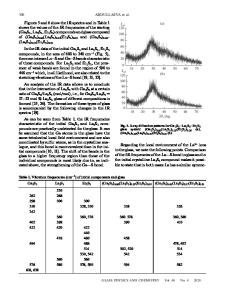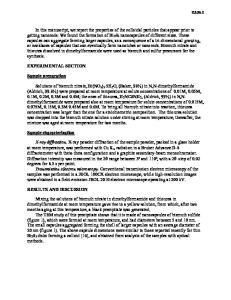Preparation, properties, and photodoping behavior of GeS 2 -, Ga 2 S 3 -, and Sb 2 S 3 -based glasses with excess sulfur
- PDF / 679,017 Bytes
- 10 Pages / 584.957 x 782.986 pts Page_size
- 98 Downloads / 410 Views
Preparation, properties, and photodoping behavior of GeS2-, Ga2S3-, and Sb2S3-based glasses with excess sulfur and CsCl Kayo Hosoya1, Yomei Tokuda2, Arifumi Okada3, Takashi Wakasugi3, Kohei Kadono3,a) 1
Graduate School of Science and Technology, Kyoto Institute of Technology, Kyoto 606-8585, Japan Department of Education, Shiga University, Otsu-city, Shiga 520-0862, Japan 3 Faculty of Materials Science and Engineering, Kyoto Institute of Technology, Kyoto 606-8585, Japan a) Address all correspondence to this author. e-mail: [email protected] 2
Received: 3 April 2019; accepted: 30 May 2019
Glasses were prepared in systems based on two stoichiometric sulfides that were selected from Ga2S3, GeS2, and Sb2S3, with the incorporation of excess sulfur and CsCl. We investigated the fundamental properties, including glass transition, density, and optical absorption, and their variations with the incorporation of excess sulfur and CsCl into the pseudo two-component sulfide glasses. The incorporation of CsCl into the GeS2–Sb2S3 glasses shifted the absorption edge at the short-wavelength side to the long-wavelength direction, particularly for glasses with more amount of GeS2 than SbS3/2. In both cases of CsCl incorporation into the Ga2S3–GeS2 glass and Ga2S3–Sb2S3 glass systems, the absorption edges shifted to the short-wavelength direction regardless of the compositions. Ag photodoping behaviors were investigated for the bulk sulfide glasses with excess sulfur and CsCl. The results are discussed based on the diffusion of silver in the glass network that is modified by the incorporation.
Introduction Bulk chalcogenide glasses have received extensive attention as the best material candidate for application to infrared optical instruments, such as night vision and surveillance cameras, because of their superior infrared transmission, mass productivity, mold formability, and low-cost raw materials [1, 2, 3]. In addition to chalcogenide glasses, recently, chalcohalide glasses that are composed of chalcogenides with the incorporation of halides except fluorides have become increasingly interesting. The incorporation of halides expands the glassforming regions of the chalcogenide glasses without deterioration of their excellent infrared transmissivity and any shift of the absorption edge at the long (infrared) wavelength side [4, 5, 6]. Furthermore, significant variations in various properties of the chalcogenide glasses are expected, e.g., thermophysical and optical properties, such as the glass transition temperature, thermal expansion coefficient, energy of the absorption edge at the short-wavelength side, and refractive index [7, 8, 9, 10, 11, 12, 13, 14]. These variations probably originate from differences between chalcogen and halogen elements in electronegativity, polarizability, and valence of the anions, whereas the
ª Materials Research Society 2019
anion sizes of the same period are close [15]. However, systematic investigations of the effects of halide incorporation on the properties of the chalcohalide glasses are limited.
Data Loading...











